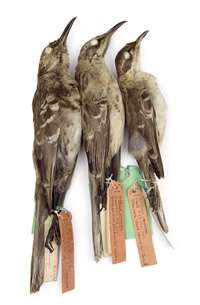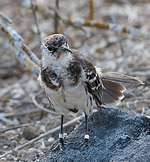Darwin's mockingbirds DNA research may help species recovery

(��������Org.com) -- New research could help protect the future of a rare bird in the Galapagos Islands that was an inspiration for Darwin’s theory of evolution by natural selection, scientists report in a paper published in the Royal Society Journal Biology Letters today.
DNA analysis has revealed the genetic structure of 2 small remaining populations of Floreana mockingbird (Mimus trifasciatus) and of some historic specimens held by the Natural History Museum and the California Academy of Sciences, including the 2 birds collected by Charles Darwin and Captain Robert FitzRoy in 1835.
They found that the population on one of the islands, called Champion, is small and inbred, and has unique genetic information not found in the larger Gardner-by-Floreana island population, but crucially, present on Floreana island in 1835.
Birds from both islets should be used to reintroduce a single, mixed population on Floreana, where the bird went extinct in the 1800s, the authors conclude.
Dr Karen James, genetics expert at the Natural History Museum said, ‘Though Darwin knew nothing of DNA, the specimens he and FitzRoy collected have, after 170 years of safe-keeping in collections, yielded genetic clues to suggest a path for conservation of this critically endangered and historically important species'.
The research is timely as we are near the end of a year of anniversary celebrations of Charles Darwin’s scientific ideas and their impact.

Scientists believe this research can help with plans to reintroduce the bird to Floreana Island, as part of a larger recovery plan for the whole island being developed by the Charles Darwin Foundation for the Galapagos Islands and Galapagos National Park Service.
Innovative genetic modelling was carried out by the team, led by the University of Zurich and including the University of Reading, the Natural History Museum and Princeton University.
They discovered that the populations living on the small satellite islands of Champion and Gardner-by-Floreana do not have long independent evolutionary histories.
In fact, they split from each other perhaps as recently as Darwin’s visit and probably as the result of the extinction of the Floreana population - a bridge between the two.
When Darwin visited the Galapagos archipelago in 1835 aboard HMS Beagle, he was struck by the differences between closely similar birds on separate islands. These differences eventually led him to question the stability of species.
Just half a century after Darwin’s visit, the Floreana mockingbird had become extinct on the island as a result of introduced predators and habitat alteration following human settlement.
Today it is one of the rarest birds in the world. Fewer than 500 individuals survive on the two tiny, satellite islands of Gardner-by-Floreana and Champion and the species is considered at risk of extinction.
Dr James concludes, 'This project highlights the value of historic specimens and it’s exciting to think that they are telling us which birds should form the basis of a reintroduction programme so that future visitors can enjoy the wildlife of these unique islands as Darwin himself did’.
More information:
Provided by American Museum of Natural History ( : )

















